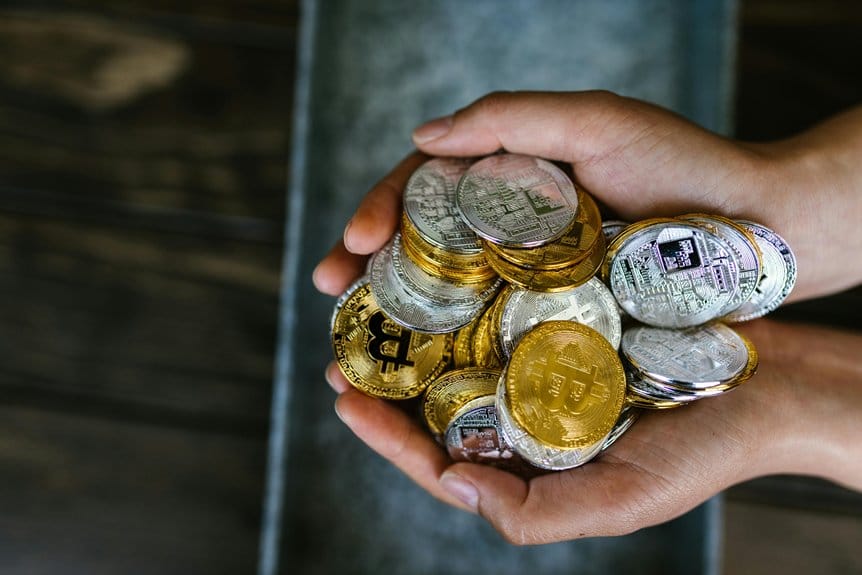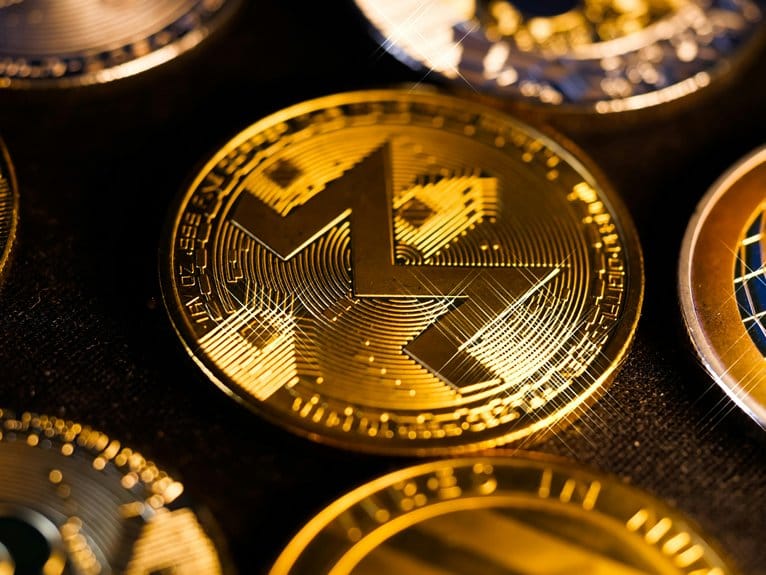Based on extensive market analysis and technological developments, key altcoins showing significant growth potential include Cardano (ADA) with its 250 TPS and energy-efficient smart contracts, Polkadot (DOT) processing 1,000 TPS per parachain, and XRP's impressive 1,500 TPS scalability. Aave's consistent $5B TVL demonstrates DeFi market strength, while Monero's privacy features attract institutional interest. The blockchain gaming sector's $4.6B valuation highlights emerging opportunities in play-to-earn tokens and metaverse projects like Decentraland, with virtual real estate transactions exceeding $500M. These metrics signal substantial growth trajectories across multiple blockchain verticals, with deeper technical analysis revealing additional market opportunities.
The Smart Contract Challenger
In the rapidly evolving blockchain landscape, Cardano (ADA) has emerged as a formidable challenger to Ethereum's smart contract dominance. Built on peer-reviewed research and developed through a rigorous scientific approach, Cardano's architecture addresses critical issues of smart contract scalability while maintaining robust security protocols.
The platform's unique layered protocol enables seamless processing of multiple transactions simultaneously, significantly reducing network congestion.
Cardano's Ouroboros proof-of-stake consensus mechanism positions it as an energy-efficient alternative, consuming only a fraction of the energy required by traditional proof-of-work systems. This technological advancement, combined with its decentralized application potential, has attracted substantial developer interest.
The platform's ability to process over 250 transactions per second (TPS), compared to Ethereum's current 15-30 TPS, demonstrates its superior throughput capabilities.
The implementation of the Alonzo hard fork has enabled full smart contract functionality, opening doors for DeFi protocols, NFT marketplaces, and complex decentralized applications.
With its treasury system funding continuous development and improvement, Cardano's ecosystem is positioned for sustained growth, making it a compelling option for developers and investors seeking advanced blockchain solutions.
Gaming's Blockchain Revolution
Several blockchain gaming tokens have revolutionized the intersection of cryptocurrency and interactive entertainment, with projects like Axie Infinity (AXS) and The Sandbox (SAND) leading the play-to-earn movement. These platforms have demonstrated substantial market growth, with the blockchain gaming sector reaching a valuation of $4.6 billion in 2022.
The implementation of play to earn mechanics has transformed traditional gaming models by enabling players to generate real economic value through gameplay. Users can acquire, trade, and monetize decentralized game assets, including virtual land, characters, and in-game items, all secured on the blockchain.
This paradigm shift has attracted both gamers and investors, with daily active users across major blockchain games exceeding 1 million players.
Projects like Illuvium (ILV) and Gala Games (GALA) are pushing the boundaries further by introducing high-quality graphics and sophisticated tokenomics.
These platforms leverage NFT technology to ensure true ownership of digital assets, while their native tokens serve multiple utilities within their respective ecosystems, including governance rights and staking opportunities.
The sector's growth trajectory suggests continued expansion, particularly as mainstream gaming studios begin exploring blockchain integration.
Privacy Coin Rising Star
Privacy-focused cryptocurrencies have seen a notable resurgence, with Monero (XMR) emerging as a dominant force in the confidential transaction space. The platform's advanced privacy features, including ring signatures and stealth addresses, have positioned it as a leading choice for users seeking enhanced anonymity levels in their transactions.
Despite regulatory challenges, Monero has maintained steady user adoption, particularly in regions where financial privacy is highly valued.
Recent technological advancements in Monero's protocol have significantly improved transaction speed and scalability, addressing previous performance limitations. The project's robust community engagement has contributed to continuous development and security improvements, while new integration options with decentralized exchanges have expanded its utility.
Market competition from newer privacy coins has intensified, yet Monero's established infrastructure and proven track record continue to attract institutional interest.
The introduction of staking rewards through mining pools has created additional incentives for network participants, strengthening the ecosystem's security.
While regulatory scrutiny of privacy coins persists, Monero's commitment to user privacy and ongoing technical innovation suggests sustained growth potential in the evolving cryptocurrency landscape.
DeFi Protocol Game Changer
Among emerging DeFi protocols, Aave (AAVE) has revolutionized decentralized lending through its innovative liquidity pool design and flash loan capabilities. The platform's total value locked (TVL) has consistently exceeded $5 billion, demonstrating strong market confidence in its infrastructure.
Aave's implementation of risk parameters and collateralization ratios has established new standards for DeFi security.
Current decentralized finance trends indicate a shift toward cross-chain compatibility, with Aave expanding to multiple networks including Polygon and Avalanche. The protocol's governance token, AAVE, serves dual functions as both a governance mechanism and risk mitigation tool through its Safety Module staking feature.
Liquidity mining strategies within Aave have evolved to incorporate variable and stable interest rates, offering users flexibility in yield optimization. The protocol's integration of Layer 2 solutions has significantly reduced transaction costs while maintaining security.
Technical analysis suggests potential for substantial growth as institutional adoption increases and DeFi market share expands. With continuous protocol improvements and a robust security track record, Aave positions itself as a cornerstone of the emerging DeFi ecosystem.
Cross-Chain Innovation Leader
While Aave has established itself in DeFi lending, Polkadot (DOT) stands at the forefront of cross-chain interoperability solutions. The platform's innovative parachain architecture enables multiple specialized blockchains to operate in parallel, significantly enhancing cross-chain scalability and network throughput.
Through its unique consensus mechanism and relay chain structure, Polkadot processes transactions across different networks with remarkable efficiency.
Polkadot's decentralized interoperability framework allows seamless communication between previously isolated blockchain ecosystems, creating a network where assets and data can flow freely. The platform's substrate development framework enables developers to launch custom blockchains that automatically inherit Polkadot's security features.
With over 100 projects building on Polkadot's infrastructure, the network demonstrates strong ecosystem growth and adoption metrics.
Market analysis indicates Polkadot's potential for substantial value appreciation, driven by its technical superiority in solving blockchain scalability challenges. The platform's ability to process up to 1,000 transactions per second per parachain, combined with its cross-chain messaging protocol, positions it as a crucial infrastructure layer for the future of decentralized applications and services.
Green Blockchain Frontrunner
Cardano (ADA) has emerged as a leading eco-friendly blockchain platform, consuming just 0.5% of Bitcoin's annual energy usage through its innovative Proof-of-Stake consensus mechanism. This significant energy efficiency positions Cardano as a prime investment opportunity in an increasingly environmentally conscious market, where institutional investors are prioritizing sustainable blockchain solutions.
The platform's commitment to sustainability initiatives extends beyond its core protocol, with the Cardano Foundation actively developing carbon-neutral blockchain implementations and fostering partnerships with green technology firms.
Market analysis indicates growing institutional interest in ADA, particularly from ESG-focused funds seeking exposure to environmentally responsible crypto assets.
Technical metrics demonstrate Cardano's superior scalability, processing over 250 transactions per second while maintaining minimal energy consumption. This efficiency-to-performance ratio surpasses many competing chains, suggesting strong potential for widespread enterprise adoption.
As regulatory pressures mount regarding cryptocurrency's environmental impact, Cardano's established green credentials and robust technological framework position it favorably for substantial growth in market share and valuation.
Recent network upgrades have further enhanced its energy-efficient smart contract capabilities, attracting developers focused on building sustainable DeFi solutions.
Web3 Infrastructure Pioneer
Polkadot (DOT) delivers essential cross-chain interoperability through its pioneering parachain architecture, enabling seamless communication between previously isolated blockchain networks.
The platform's innovative sharding mechanism allows for parallel transaction processing, significantly enhancing network throughput while maintaining security across its ecosystem of connected chains.
At the core of Polkadot's infrastructure lies its sophisticated decentralized governance model, which empowers DOT holders to participate in protocol-level decision-making through on-chain voting.
This democratic approach ensures continuous evolution and refinement of the network's scalability solutions, while maintaining alignment with stakeholder interests.
The platform's relay chain coordinates up to 100 parachains, each capable of processing 1,000 transactions per second.
This architectural design positions Polkadot as a foundational layer for Web3 development, supporting diverse applications from DeFi to IoT solutions.
Recent network upgrades have enhanced cross-chain message passing (XCMP) capabilities, further solidifying Polkadot's role in facilitating seamless asset and data transfers across its expanding ecosystem.
With over $3 billion in total value locked and growing institutional adoption, Polkadot demonstrates strong potential for long-term value appreciation in the Web3 infrastructure space.
Next-Gen Payment Solution
Among prominent altcoins, XRP stands out as a next-generation payment protocol designed to facilitate near-instantaneous cross-border transactions at minimal cost. The platform's architecture enables settlement times of 3-5 seconds, significantly outperforming traditional banking systems that typically require 3-5 business days. This efficiency has attracted over 300 financial institutions worldwide to explore or implement XRP's technology.
Recent transaction speed enhancements have further optimized the network's performance, allowing it to handle 1,500 transactions per second with scalability potential reaching 50,000 TPS through horizontal scaling. The protocol's digital wallet integration capabilities enable seamless connectivity with existing banking infrastructure, making it particularly attractive for financial institutions seeking to modernize their payment systems.
XRP's market position is strengthened by its focus on regulatory compliance and partnerships with major financial players. The platform's On-Demand Liquidity (ODL) service has shown consistent growth, with quarterly ODL volume exceeding $8 billion in recent reports.
This technological foundation, combined with its established market presence, positions XRP as a leading contender in the evolution of global payment systems.
Metaverse Building Block
Decentraland (MANA) has emerged as a foundational cryptocurrency powering metaverse development, with its virtual real estate transactions exceeding $500 million in total volume since inception. The platform leverages blockchain interoperability to facilitate decentralized ownership of digital assets within its tokenized environments, enabling users to buy, sell, and develop virtual parcels of land.
MANA's ecosystem emphasizes user generated content and community engagement through its spatial computing architecture, allowing developers to create immersive experiences ranging from games to virtual marketplaces. The platform's integration of virtual reality technologies has attracted major brands and institutions, contributing to a 300% increase in active users during 2022.
The metaverse building block operates on a dual-token system, with MANA serving as the transactional currency and LAND representing ownership of virtual spaces. This structure supports augmented interaction between users while maintaining secure property rights through smart contracts.
Analysis indicates that Decentraland's focus on interoperable standards and developer-friendly tools positions it strategically for continued growth in the expanding metaverse sector, with market projections suggesting a potential $800 billion valuation by 2026.
Enterprise Blockchain Solution
Innovation in enterprise blockchain technology has positioned Polkadot (DOT) as a leading solution for cross-chain business operations, with its parachain architecture processing over 1 million transactions daily across integrated networks.
The platform's modular framework effectively addresses enterprise scalability challenges through parallel processing capabilities, enabling businesses to maintain independent chains while benefiting from the network's shared security model.
As organizations navigate enterprise adoption hurdles, Polkadot's interoperability protocol facilitates seamless data exchange between private and public blockchains, crucial for complex business ecosystems.
The network's governance structure allows stakeholders to participate in protocol upgrades and technical implementations, ensuring alignment with evolving enterprise requirements.
With a market capitalization exceeding $7 billion, Polkadot demonstrates strong institutional backing and technical maturity.
Its substrate development framework accelerates enterprise blockchain deployment, reducing time-to-market for custom solutions.
The platform's upcoming improvements in cross-chain messaging and smart contract functionality position it strategically for expanded enterprise adoption, particularly in sectors requiring high-throughput transaction processing and sophisticated data management capabilities.
Frequently Asked Questions
How Do Altcoins Affect Traditional Stock Market Investments?
Altcoin correlations with traditional stocks remain relatively weak, though increased institutional crypto adoption can amplify market volatility during major economic events, potentially affecting conventional portfolio performance across both sectors.
What Tax Implications Should Investors Consider When Trading Multiple Altcoins?
Cryptocurrency traders must track each altcoin transaction for capital gains reporting, with tax obligations applying to coin-to-coin trades, sales, and conversions based on realized profits and holding periods.
How Can Investors Protect Themselves From Altcoin Pump-And-Dump Schemes?
Investors can combat pump-and-dump strategies through rigorous market analysis, verification of trading volumes, scrutiny of social media patterns, and comprehensive investor education regarding price manipulation tactics and suspicious trading activities.
Which Hardware Wallets Are Most Reliable for Storing Multiple Altcoins?
Leading hardware wallet comparisons indicate Ledger Nano X and Trezor Model T offer comprehensive altcoin storage solutions, featuring extensive cryptocurrency support, secure offline storage, and robust firmware protection against cyber threats.
When Is the Best Time During Market Cycles to Invest in Altcoins?
Optimal altcoin investment timing aligns with market cycles during Bitcoin's consolidation phases. Strategic entry points occur post-BTC rallies when capital typically flows to altcoins, creating momentum-driven growth opportunities.
Conclusion
The altcoin landscape continues to evolve with promising innovations across multiple sectors. These top 10 selections demonstrate strong technological fundamentals, institutional adoption potential, and strategic market positioning. From smart contract optimization to enterprise blockchain solutions, each project addresses specific market needs while pushing technological boundaries. Careful analysis of development activity, partnership announcements, and adoption metrics suggests significant growth potential in these carefully selected cryptocurrencies through 2024.





